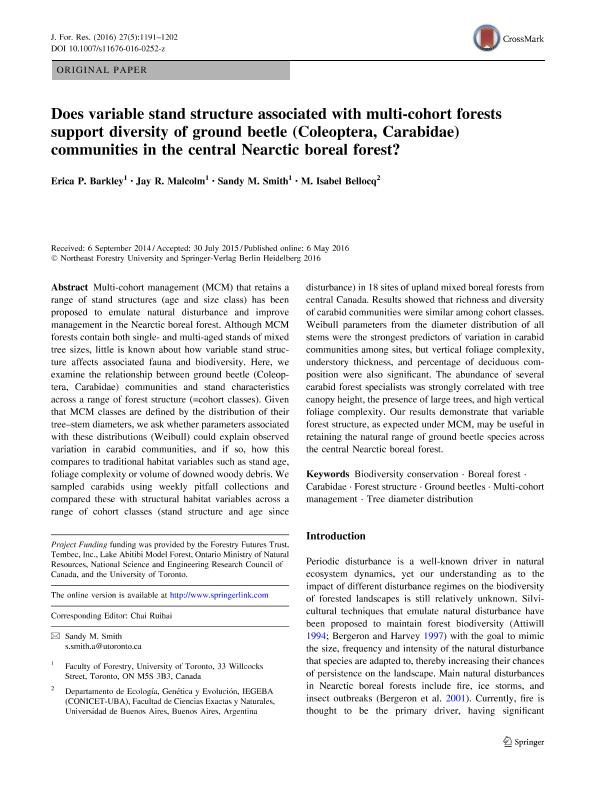Artículo
Does variable stand structure associated with multi-cohort forests support diversity of ground beetle (Coleoptera, Carabidae) communities in the central Nearctic boreal forest?
Fecha de publicación:
10/2016
Editorial:
Springer
Revista:
Journal of Forestry Research
ISSN:
1007-662X
e-ISSN:
1993-0607
Idioma:
Inglés
Tipo de recurso:
Artículo publicado
Clasificación temática:
Resumen
Multi-cohort management (MCM) that retains a range of stand structures (age and size class) has been proposed to emulate natural disturbance and improve management in the Nearctic boreal forest. Although MCM forests contain both single- and multi-aged stands of mixed tree sizes, little is known about how variable stand structure affects associated fauna and biodiversity. Here, we examine the relationship between ground beetle (Coleoptera, Carabidae) communities and stand characteristics across a range of forest structure (=cohort classes). Given that MCM classes are defined by the distribution of their tree–stem diameters, we ask whether parameters associated with these distributions (Weibull) could explain observed variation in carabid communities, and if so, how this compares to traditional habitat variables such as stand age, foliage complexity or volume of downed woody debris. We sampled carabids using weekly pitfall collections and compared these with structural habitat variables across a range of cohort classes (stand structure and age since disturbance) in 18 sites of upland mixed boreal forests from central Canada. Results showed that richness and diversity of carabid communities were similar among cohort classes. Weibull parameters from the diameter distribution of all stems were the strongest predictors of variation in carabid communities among sites, but vertical foliage complexity, understory thickness, and percentage of deciduous composition were also significant. The abundance of several carabid forest specialists was strongly correlated with tree canopy height, the presence of large trees, and high vertical foliage complexity. Our results demonstrate that variable forest structure, as expected under MCM, may be useful in retaining the natural range of ground beetle species across the central Nearctic boreal forest.
Archivos asociados
Licencia
Identificadores
Colecciones
Articulos(IEGEBA)
Articulos de INSTITUTO DE ECOLOGIA, GENETICA Y EVOLUCION DE BS. AS
Articulos de INSTITUTO DE ECOLOGIA, GENETICA Y EVOLUCION DE BS. AS
Citación
Barkley, Erica P.; Malcolm, Jay R.; Smith, Sandy M.; Bellocq, Maria Isabel; Does variable stand structure associated with multi-cohort forests support diversity of ground beetle (Coleoptera, Carabidae) communities in the central Nearctic boreal forest?; Springer; Journal of Forestry Research; 27; 5; 10-2016; 1191-1202
Compartir
Altmétricas




